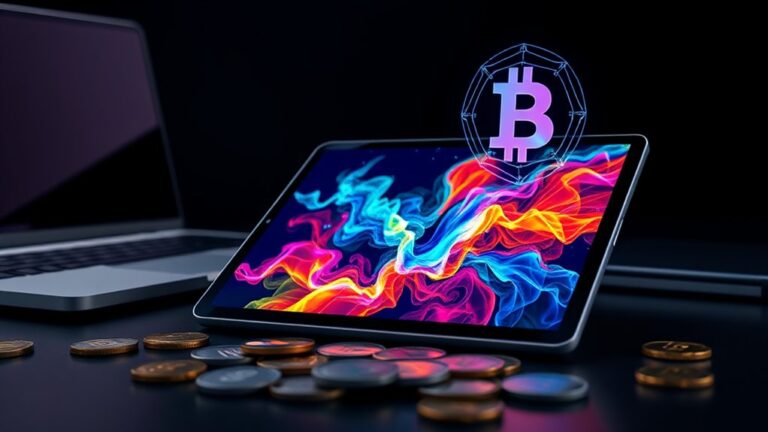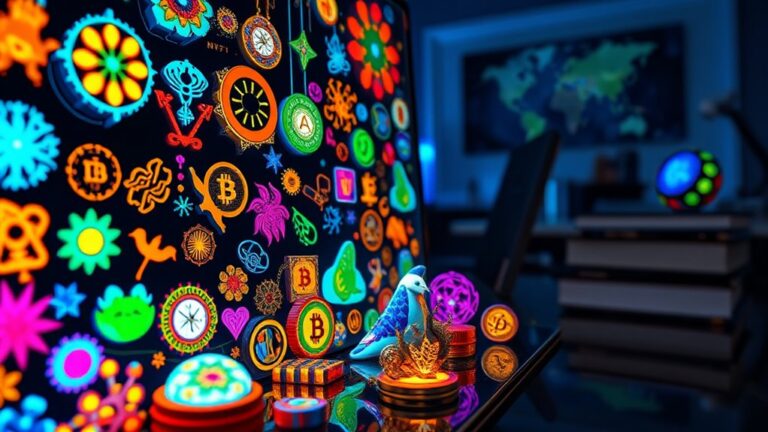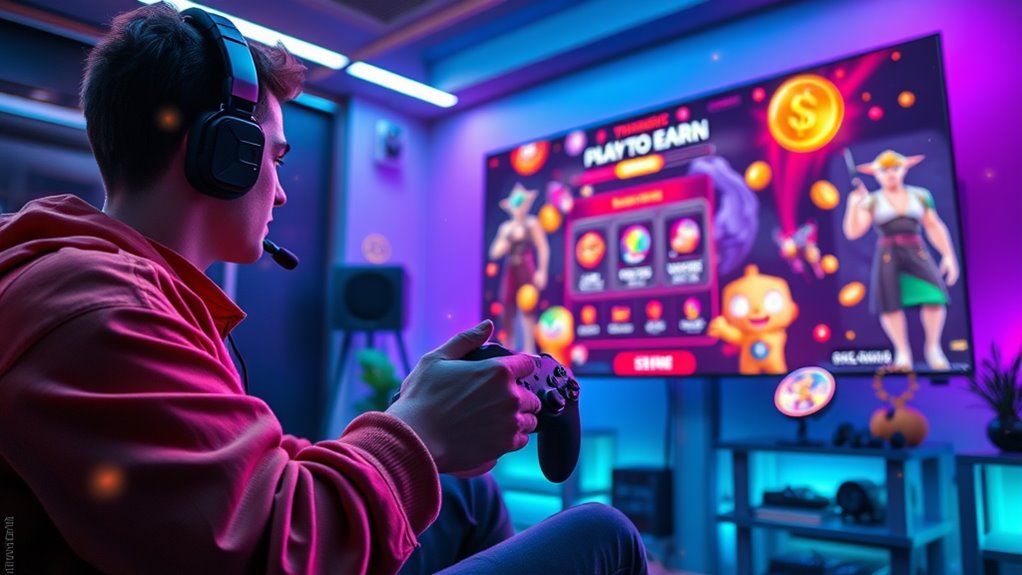
Gaming NFTs and Play-to-Earn Models: What Are They & How Do They Work?
Gaming NFTs, or non-fungible tokens, are unique digital assets that grant players true ownership of in-game items, characters, and virtual real estate on blockchain platforms. Play-to-earn models allow gamers to earn cryptocurrency or NFTs through gameplay activities such as completing quests and trading items. This approach reshapes traditional gaming by emphasizing player ownership and value. Players navigate economic ecosystems governed by tokenomics, presenting both opportunities and challenges. Further exploration reveals intricate details about their functionality and implications.
Key Takeaways
- Gaming NFTs represent unique digital assets on a blockchain, enabling true ownership of in-game items, avatars, and virtual real estate.
- Play-to-earn games allow players to earn cryptocurrency or NFTs by completing quests, trading items, or winning battles within the game.
- Transactions in these games are secure and transparent through blockchain technology, ensuring players can trade assets directly and safely.
- Tokenomics govern the supply and demand of in-game assets, creating an ecosystem where players can earn real value from their gaming activities.
- Challenges include NFT value volatility, regulatory uncertainty, and environmental concerns, which need to be addressed for sustainable growth in the gaming industry.
Understanding Gaming NFTs: Definition and Benefits
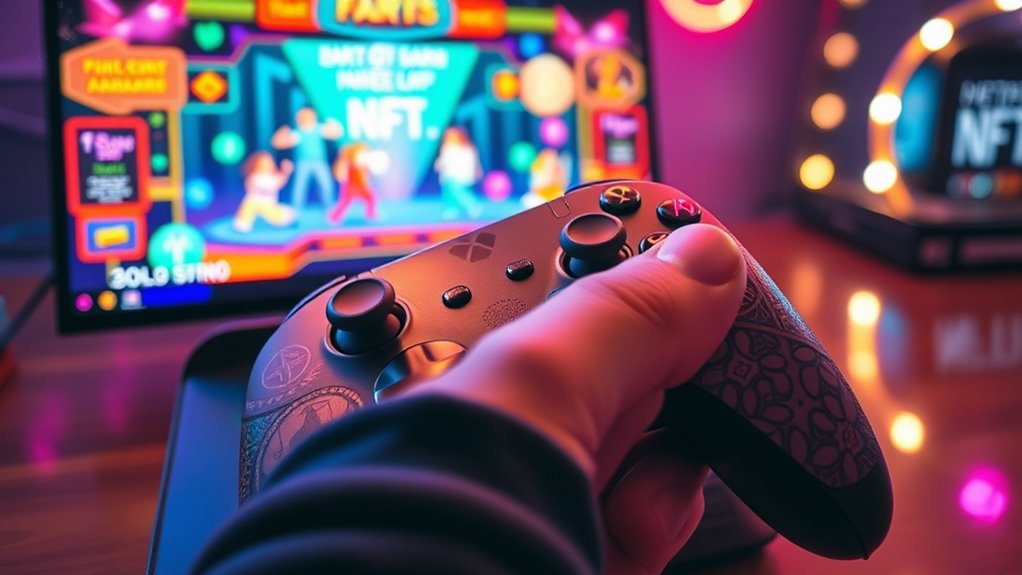
In the domain of digital entertainment, gaming NFTs, or non-fungible tokens, have emerged as a significant innovation. These tokens represent ownership of unique digital assets, verified on a blockchain. Unlike cryptocurrencies, NFTs are not interchangeable; they resemble one-of-a-kind trading cards.
In gaming, they can represent in-game items such as skins, weapons, and characters, each with a distinct digital signature that guarantees scarcity. The primary benefits of NFTs in gaming include providing true digital ownership, allowing players to buy, sell, and trade assets like physical items.
Additionally, they enhance security through blockchain transactions, helping prevent duplication or hacking. Furthermore, NFTs enable players to capture value from their in-game investments, creating a more engaging gaming experience, while also impacting supply chain management by enhancing product authenticity and tracking.
Types of NFTs in Gaming
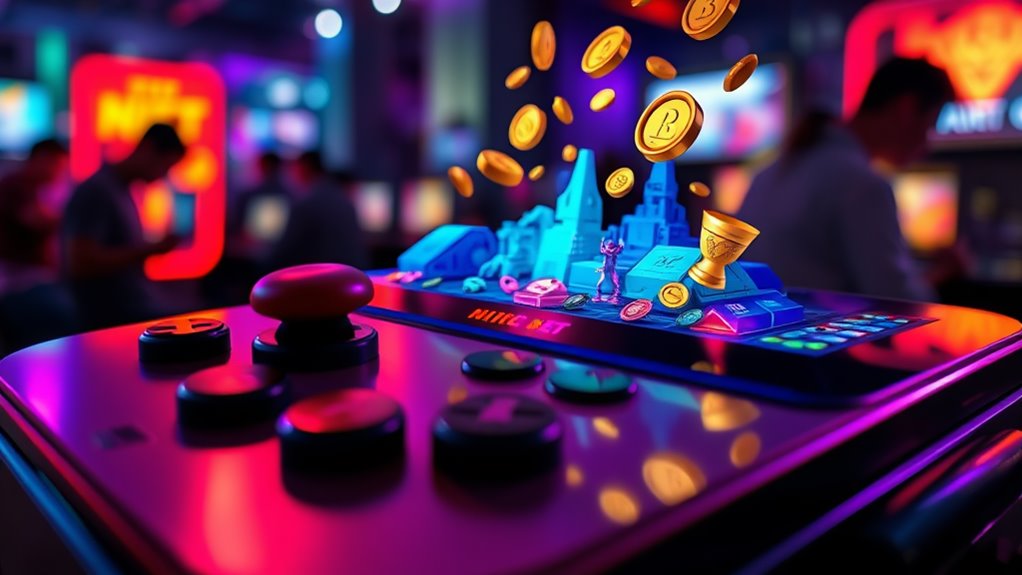
Gaming NFTs come in various forms, each serving a distinct purpose within the gaming ecosystem. One type includes in-game items, which can represent assets like weapons and armor.
Another type is virtual real estate, allowing players to own unique plots of land in environments like Decentraland. Game avatars are also popular NFTs, enabling players to create and customize their characters.
Virtual real estate and customizable game avatars empower players to create unique experiences within immersive environments like Decentraland.
Additionally, digital artwork can serve as collectibles within games. Unique game characters, represented as NFTs, often possess special abilities, adding depth to gameplay.
Moreover, the utility-driven NFTs trend is gaining traction in gaming, offering players exclusive rewards and governance rights that enhance their experience. Examples of these NFTs can be seen in games such as Gods Unchained and Axie Infinity, where ownership and tradeability enhance player engagement and foster a thriving digital marketplace.
Exploring Play-to-Earn Games: An Overview
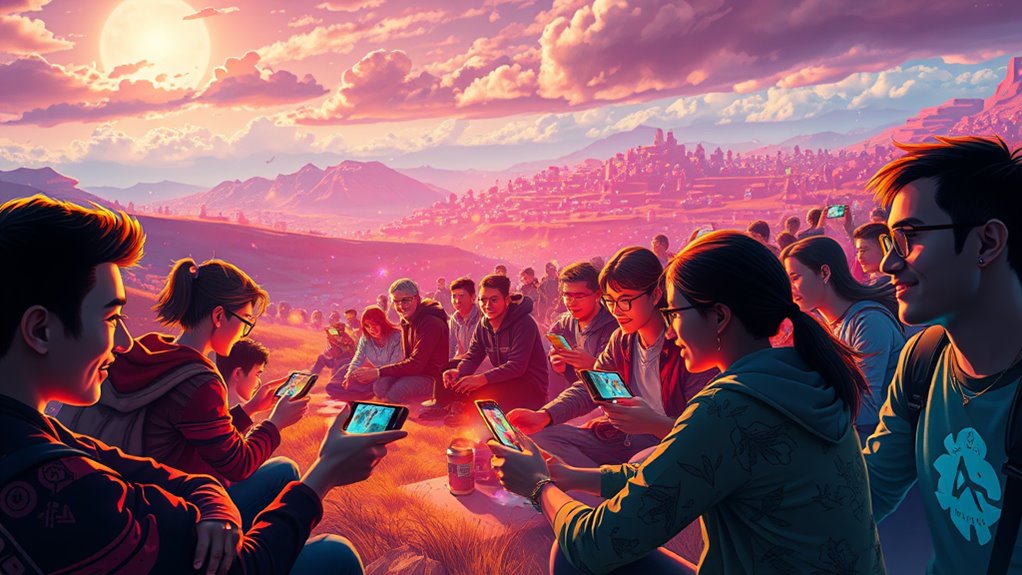
Play-to-earn games have emerged as a significant trend in the gaming industry, particularly due to their integration with blockchain technology.
These games allow players to earn cryptocurrency or NFTs while enjoying gameplay, combining entertainment with the potential for financial gain. Popular examples include Axie Infinity and Decentraland, which have attracted considerable attention for their innovative models.
Players can earn rewards by engaging in various activities, such as completing quests or trading in-game items. The value of these digital assets can be transferred and sold outside the gaming environment, providing tangible benefits. This trend aligns with the rise of utility NFTs, which offer additional advantages beyond ownership, reshaping perceptions of gaming and creating new career opportunities while emphasizing player ownership of digital assets within the evolving landscape of interactive entertainment.
How Play-to-Earn Games Function
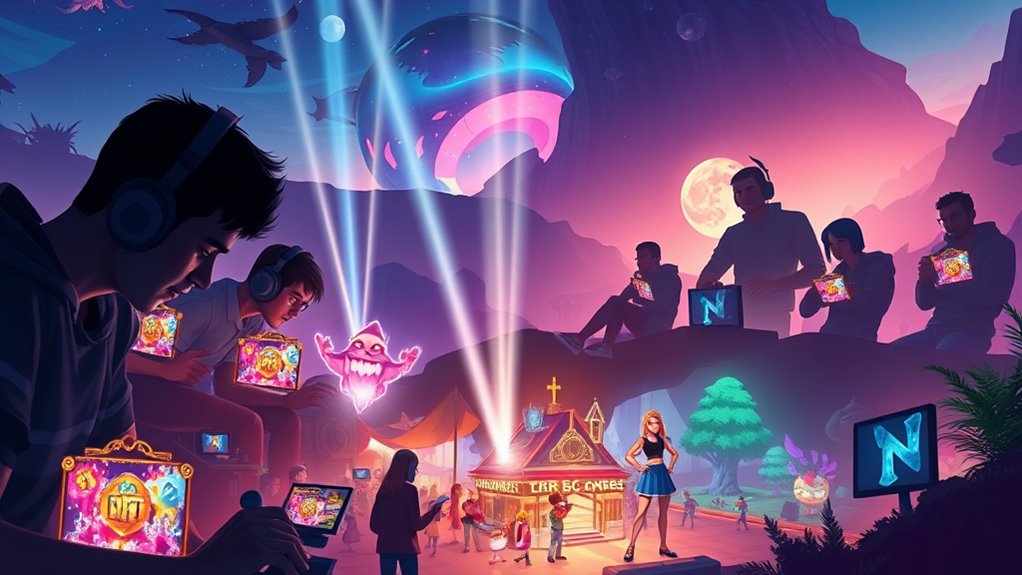
While many traditional games restrict ownership of in-game assets to developers, play-to-earn games leverage blockchain technology to empower players with true ownership of their digital assets.
These games operate on a blockchain platform, ensuring transparency and security in transactions. Players earn tokens or NFTs by completing quests, winning battles, or simply participating in the game.
Smart contracts facilitate secure transactions, while decentralized exchanges allow players to trade assets directly. The in-game economy thrives through active markets where players buy, sell, and trade assets.
Smart contracts ensure secure transactions, enabling players to trade assets directly in a vibrant in-game economy.
Tokenomics governs the supply and demand of these digital assets, contributing to an ecosystem where players can earn real value from their in-game activities. This innovative model is reshaping the gaming landscape and allows players to enjoy the uniqueness of NFTs as they engage in their gaming experiences.
Advantages of Play-to-Earn Models
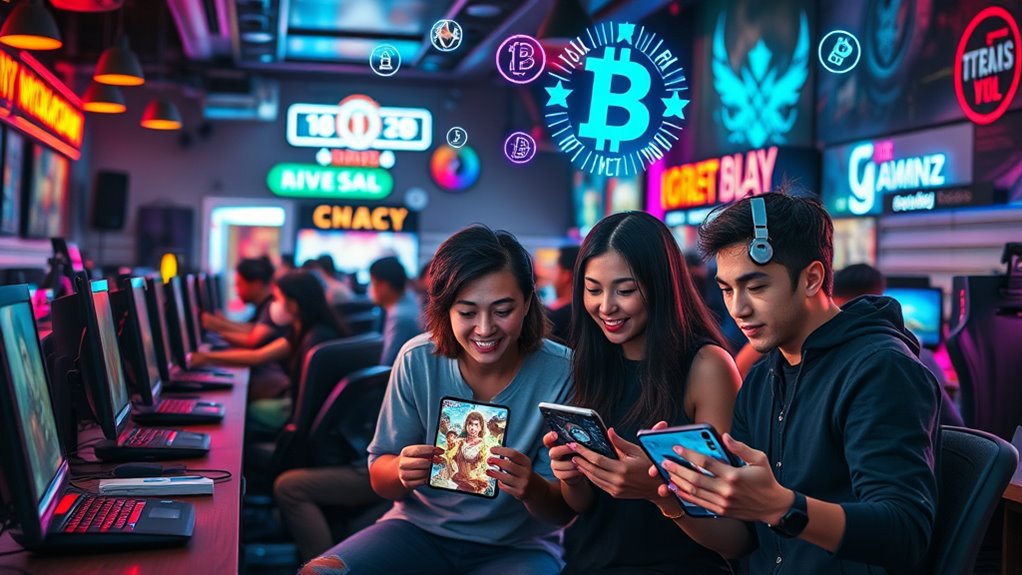
As the gaming landscape continues to evolve, the advantages of play-to-earn models become increasingly apparent.
These models provide financial inclusion by offering income opportunities, particularly in regions with limited job markets. Players can earn cryptocurrencies and NFTs, which hold real-world value and can be traded or sold.
Unlike traditional games, where in-game progress holds no monetary value, play-to-earn models monetize players’ skills. Additionally, assets acquired in these games can appreciate, presenting investment potential.
Players enjoy decentralized ownership of their in-game assets, fostering transparency and security through blockchain technology. This model encourages community engagement, as players actively participate in the game’s economy, enhancing both social interaction and collaboration among users. Furthermore, similar to music NFTs, play-to-earn games enable players to have transparent ownership of their digital assets, further enhancing their engagement and investment in the gaming ecosystem.
Challenges and Future Directions in Gaming NFTs and Play-to-Earn
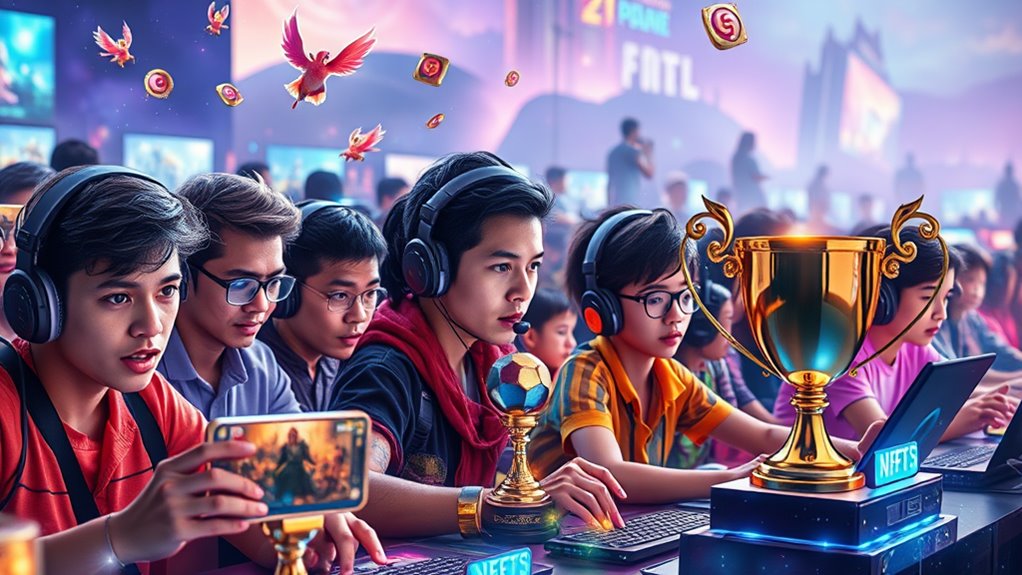
The gaming industry faces several challenges and uncertainties as it navigates the integration of NFTs and play-to-earn models.
Key issues include the volatility of NFT values, regulatory uncertainty, and intense market competition, which complicate investment decisions. Technical challenges, such as blockchain scalability and security risks, further impede growth.
Additionally, maintaining player engagement and ensuring economic balance within games are critical for sustainability. As the industry looks forward, advancements in blockchain technology and greater mainstream acceptance could help address these challenges.
Furthermore, the environmental impact of NFTs, including their substantial carbon emissions, has emerged as a significant concern that the gaming sector must consider in its development strategies.
Collaboration between game developers and blockchain experts may foster innovative gameplay mechanics, while efforts to clarify regulations will be essential for creating a secure and trustworthy environment for players and investors alike.
Frequently Asked Questions
How Can I Create My Own Gaming NFTS?
To create gaming NFTs, one must define unique digital assets, select a blockchain, develop smart contracts, and design engaging gameplay. Careful planning guarantees these NFTs offer value and enhance player experience within the game.
Are Gaming NFTS Environmentally Friendly?
The environmental friendliness of gaming NFTs is debated, primarily due to their energy-intensive blockchain transactions. However, advancements like proof-of-stake and layer-two solutions may mitigate their carbon footprint, fostering more sustainable practices in the future.
What Happens if a Game Shuts Down?
If a game shuts down, players may lose access to their assets, risking financial loss. Community bonds can fray, and developers’ reputations might suffer, while market values of assets can fluctuate dramatically due to diminished demand.
Can I Use NFTS Across Different Games?
Interoperability allows NFTs to be utilized across different games, enhancing their value and player engagement. However, challenges such as technical compatibility and economic balance must be addressed for seamless integration and effective cross-platform usage.
How Do I Evaluate the Value of an NFT?
To evaluate the value of an NFT, one should consider factors like rarity, artist recognition, transaction history, and market trends, employing techniques such as relative valuation, liquidity premium analysis, and community engagement insights for accurate assessments.
Conclusion
To summarize, gaming NFTs and play-to-earn models represent a revolutionary shift in the gaming landscape, transforming players into potential earners in an exhilarating digital economy. The allure of owning unique in-game assets, combined with the opportunity to generate income, captivates many enthusiasts. However, as this dynamic sector evolves, it faces challenges that demand careful consideration. The future of gaming may hinge on these developments, making it an exciting yet uncertain frontier for players and creators alike.


